Affordability of properties on the Wrocław real estate market
DOI:
https://doi.org/10.15611/br.2024.1.02Keywords:
affordability of property, Wrocław real estate marketAbstract
Aim: To capture changes in the affordability of properties at their purchase on the primary and secondary Wrocław real estate markets in the years 2013-2022.
Methodology: Studies into the affordability of properties are conducted using the traditional approach (quantitative indicators), the behavioural approach (e.g. questionnaires), and the extended approach (quantitative indicators and qualitative criteria). This analysis follows the traditional approach. To measure the affordability of properties, the income method was used by constructing an indicator based on the average monthly gross income, property size and average prices per square metre of properties in transactions on the primary and secondary real estate markets using a variant approach, i.e. dependent on the area of liveable space.
Results: In the years 2013-2022 on the primary and secondary real estate market there was no tendency indicating a systematic improvement or worsening in the affordability of properties for Wrocław inhabitants. Comparing the data from the years at either end of the analysis (2013, 2022), the affordability of properties in Wrocław improved on the primary real estate market and worsened on the secondary market. Regardless of these changes, it should be noted that the prices of properties in relation to the average gross income is not favourable, limiting potential buyers to the wealthy.
Implications and recommendations: Meeting consumer housing needs on the basis of ownership rights does not resolve Wrocław’s housing problems. The limited affordability of properties in purchase transactions clearly indicates the need for additional action to be taken to support the construction of social housing and the development of the commercial rental property market.
Originality/value: Traditionally, research into the affordability of property usually focuses on the average income of the population and the average prices of properties calculated per square metre, or the medians of these figures. These approaches ignore the influence of property size on its affordability. The proposed indicator eliminates this shortcoming. Assessment of the affordability of property on the Wrocław real estate market is one of the bases for shaping local housing policy.
Downloads
References
Cyran, R. (2020). Analizy dostępności rynku mieszkaniowego na potrzeby zintegrowanej polityki mieszkaniowej. Instytut Rozwoju Miast i Regionów.
Czerniak, A., Czaplicki, M., Mokrogulski, M., & Niedziółka, P. (2022). Dostępność finansowa mieszkań w krajach Europy ŚrodkowoWschodniej na tle zmian parametrów polityki pieniężnej. In M. Strojny (Ed.), Raport SGH i Forum Ekonomicznego 2022 (pp. 86-108). Szkoła Główna Handlowa w Warszawie. https://cor.sgh.waw.pl/handle/20.500.12182/1206
Ezennia, I. S., & Hoskara, S. O. (2022). Applications of housing affordability measurement approaches used in planning affordable housing: A systematic review. Journal of Building Construction and Planning Research, 10, 1-36. https://doi.org/10.4236/jbcpr.2022.101001
Flint, J. & Rowlands, R. (2003). Commodification, normalization and intervention: Cultural, social and symbolic capital in housing consumption and governance. Journal of Housing and the Built Environment, 8(3), 213-232. https://doi.org/10.1023/A:1025113329508
Główka, G. (2012). System finansowania nieruchomości mieszkaniowych w Polsce. Doświadczenia i kierunki zmian. Oficyna Gorzeń-Mitka, I. (2022). Dostępność i jakość zasobów mieszkaniowych – porównanie wielokryterialne gmin miejskich województwa wielkopolskiego metodą MULTIMOORA. Rozwój Regionalny i Polityka Regionalna, 62(5), 183-197. Wydawnicza Szkoły Głównej Handlowej.
Główny Urząd Statystyczny [GUS]. (2023). Gospodarka mieszkaniowa i infrastruktura komunalna w 2022 roku. https://stat.gov.pl/obszary-tematyczne/infrastruktura-komunalna-nieruchomosci/nieruchomosci-budynkiinfrastruktura-komunalna/gospodarka-mieszkaniowa-i-infrastruktura-komunalna-w-2022-roku,13,17.html
Główny Urząd Statystyczny [GUS]. (2024). Bank Danych Lokalnych. https://bdl.stat.gov.pl
Henderson, J. V. & Ioannides, Y. M. (1983). A model of housing tenure choice. American Economic Review, 73(1), 98-111. Retrieved from https://www.jstor.org/stable/1803929
Kokot, S. (2022). Realne ceny mieszkań na rynku wtórnym w wybranych miastach w Polsce. Wiadomości Statystyczne, 67(3), 46-65. https://doi.org/10.5604/01.3001.0015.8066
Komisja Europejska. (2017). Europejski filar praw socjalnych. https://ec.europa.eu/social/main.jsp?catId=1226&langId=pl
Konstytucja Rzeczypospolitej Polskiej z dnia 2 kwietnia 1997 r. (t.j. Dz.U. z 1997 r. nr 78, poz. 483).
Kucharczyk-Brus, B. (2021). Ocena jakości mieszkań w zabudowie wielorodzinnej – raport z badań ankietowych. Builder, 287(6), 13-15. https://doi.org/10.5604/01.3001.0014.8659
Lis, P. (2021). Wspólnie czy indywidualnie? Na własność czy wynajem? Wszystkim czy wybranym? Dylematy współczesnej polskiej polityki mieszkaniowej. Studia BAS, 2, 35-50. https://doi.org/10.31268/StudiaBAS.2021.16
Marona, B., & Tomasik, K. (2023). Problem dostępności mieszkań w Polsce w kontekście realizowanych programów polityki mieszkaniowej w latach 2016-2022. Studia BAS, (4), 27-53. https://doi.org/10.31268/StudiaBAS.2023.29
Matel, A. (2020). Właściciele i najemcy. Status mieszkaniowy gospodarstw domowych w Polsce. Wydawnictwo Uniwersytetu w Białymstoku.
Milewska-Wilk, H. & Nowak, K. (2022). Dane o mieszkalnictwie w Polsce. Instytut Rozwoju Miast i Regionów.
Ministerstwo Rozwoju i Technologii. (2019). Cele zrównoważonego rozwoju. https://www.gov.pl/web/rozwoj-technologia/cele-zrownowazonego-rozwoju
Robinson, M., Scobie, G. M., & Hallinan, B. (2006). Affordability of housing: Concepts, measurement and evidence. New Zealand Treasury Working Paper, 06/03, 1-52.
Samorek, B., & Cichocki, M. (2023). Polski rynek nieruchomości mieszkaniowych. Instytut Rozwoju Miast i Regionów.
Sępoch-Ożyńska, A. (2022). Elastyczność kształtowania przestrzeni mieszkalnej w budynkach wielorodzinnych. MAZOWSZE Studia Regionalne, (41), 37-46. https://doi.org/10.21858/msr.41.03
Stone, M. E. (2006). What is housing affordability? The case for the residual income approach. Housing Policy Debate, 17(1), 151–184. https://doi.org/10.1080/10511482.2006.9521564
Strączkowski, Ł. (2009). Motywy zakupu mieszkań w świetle badań nabywców na lokalnym rynku mieszkaniowym w Poznaniu. Studia i Materiały Towarzystwa Naukowego Nieruchomości, 17(2), 45-55.
Trojanek, R. (2014). Dostępność mieszkaniowa w wybranych miastach w Polsce w latach 1997-2012. Biuletyn Stowarzyszenia Rzeczoznawców Majątkowych Województwa Wielkopolskiego, 1-2, 5-7.
Tyrawa, D. (2023). Zaspokajanie potrzeb mieszkaniowych jako cel gminnych programów mieszkaniowych. Prawo i Więź, 4(47), 671-687.
Ustawa z dnia 15 grudnia 2000 r. o spółdzielniach mieszkaniowych (t.j. Dz.U. z 2001 r. nr 4, poz. 27).
Ustawa z dnia 21 czerwca 2001 r. o ochronie praw lokatorów, mieszkaniowym zasobie gminy i o zmianie Kodeksu cywilnego (t.j. Dz.U. z 2001 r. nr 71, poz. 733). Ustawa z dnia 10 grudnia 2020 r. o zmianie niektórych ustaw wspierających rozwój mieszkalnictwa (Dz.U. z 2021 r., poz. 11).
Zakrzewska-Półtorak, A. i Pluta, A. (2023). Zmiany w zakresie atrakcyjności nieruchomości mieszkaniowych w polskich miastach w latach 2010-2020, ze szczególnym uwzględnieniem dostępności. Prace Naukowe Uniwersytetu Ekonomicznego we Wrocławiu, 67(3), 164-176.
Downloads
Published
Issue
Section
License
Copyright (c) 2025 Dariusz Głuszczuk

This work is licensed under a Creative Commons Attribution-ShareAlike 4.0 International License.
Accepted 2024-12-06
Published 2025-01-31







